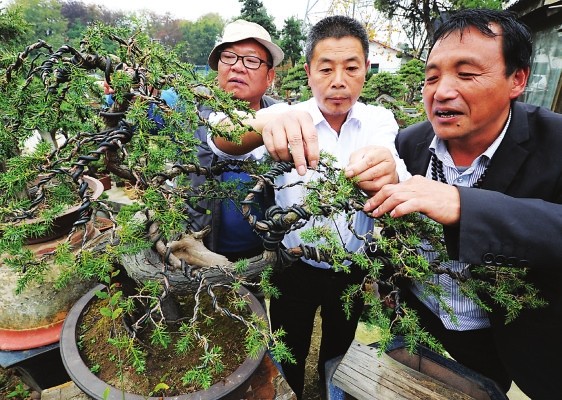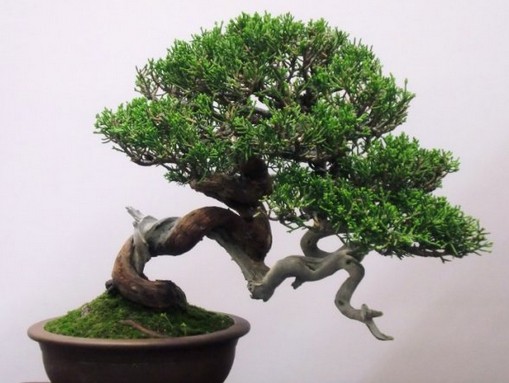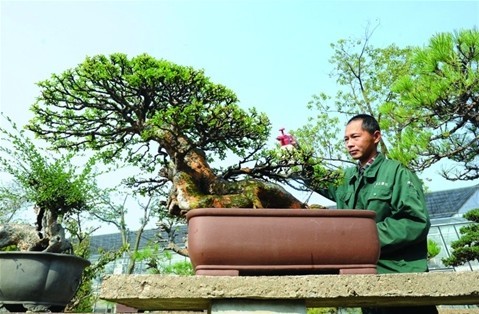The climbing technique of Su Pai Bonsai
Suzhou bonsai is traditionally climbing with brown silk, which has the advantage of harmonious color between brown silk and bark, and the ornamental value of pile scenery after climbing is higher. The brown silk climbing is more difficult, from the climbing skills can be seen, the main link is to master the brown climbing focus, brown silk thickness should be appropriate. In order to meet the needs of rapid development, the main method is aluminum wire climbing, supplemented by brown wire, and its main technology is the same as that of brown wire.

Su-style bonsai has different climbing techniques and pruning methods due to different tree species. Ancient piles are generally vigorous and simple, full of natural posture, but also can not be bent, as long as the branches are slightly tied, this method is called "semi-ligation method". When the bonsai is processed and cultivated with seedlings, its trunk and branches should be clamped up, which is called "full ligation".
1. Full ligation
The materials used are saplings, and all the trunks and branches should be climbed. The climbing order of the full ligation method is to tie the trunk first and then the branches and leaves. The trunk is pierced from the lower part to the top, and the viewing surface of the stump must be determined before it is fastened. Bonsai experts call it the "front". Then the shape of the bonsai is determined according to the natural shape of the stump. The styles of full-tie method are Panqu type, horizontal dry type, cliff type and so on. Cite the Panqu style as an example, which is characterized by the "S" shape of the tree trunk, spiraling upward. When climbing, the trunk is facing forward, according to the trunk size, choose the appropriate brown silk, fixed in the lowest part of the trunk, preferably in the section scar, the brown silk is not easy to slide. Then twist the brown silk around, choose the appropriate part of the upper part of the trunk to tie a knot, cut off the excess brown silk with scissors, and complete the first song of the trunk. The second and third songs are the key to climbing. The lower position of the second song is generally about 1/5 in the middle of the first song. After fixing the brown silk, twist it a few times, and choose the appropriate part of the upper part of the trunk to tie the knot, which completes the second song. The third song only needs to climb upward along the "S" shape. Usually it can be topped after three songs. After the trunk climbing is completed, you can climb and bind the branches and leaves, also known as leaves. When climbing the leaves, first use the brown silk to fix the branches on the slightly lower trunk, twist the brown silk around a few times, and bend the upward branches with the right hand, showing a horizontal or slightly lower horizontal shape. Then select the appropriate part of the branch, with brown silk fixed into a small qu, for semi-qu …... Then use brown silk to pass through the semi-curve, twist it from side to side, tie a knot in the appropriate part of the branch and fix it into a curve, and then tie it forward to complete two and a half curves. The top leaves can generally be fastened according to the trunks.
2. Semi-ligation method
Most of Suzhou bonsai are mainly excavated wild piles. The trunk of the old stump excavated from the wilderness hills has been shaped and cannot be bent. For this kind of stump, as long as the shape of the trunk is determined according to the natural posture of the trunk, only the branches are clambered, first half, then one bend, and then the second bend; there are "one and a half", "two and a half", and few "three and a half".
Time: 2019-06-04 Click:
- Prev

Selection of Su-style bonsai tree species and their modeling techniques
Su-style bonsai is one of the five major schools of Chinese bonsai, which consists of two parts: tree stump bonsai and water-stone bonsai. The most common varieties of stump bonsai are pine and cypress, sparrow plum, elm, yellow poplar, triangular maple, maple, crape myrtle, pomegranate, ginkgo and so on.
- Next

Pruning Technology of Suzhou Bonsai Modeling Technology
Suzhou bonsai modeling skills have high requirements for pruning. There are two main pruning techniques: dormant pruning and growing pruning. Dormancy period: occurs mainly in winter, begins after defoliation and ends before spring germination
Related
- Fuxing push coffee new agricultural production and marketing class: lack of small-scale processing plants
- Jujube rice field leisure farm deep ploughing Yilan for five years to create a space for organic food and play
- Nongyu Farm-A trial of organic papaya for brave women with advanced technology
- Four points for attention in the prevention and control of diseases and insect pests of edible fungi
- How to add nutrient solution to Edible Fungi
- Is there any good way to control edible fungus mites?
- Open Inoculation Technology of Edible Fungi
- Is there any clever way to use fertilizer for edible fungus in winter?
- What agents are used to kill the pathogens of edible fungi in the mushroom shed?
- Rapid drying of Edible Fungi

